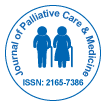Nuestro grupo organiza más de 3000 Series de conferencias Eventos cada año en EE. UU., Europa y América. Asia con el apoyo de 1.000 sociedades científicas más y publica más de 700 Acceso abierto Revistas que contienen más de 50.000 personalidades eminentes, científicos de renombre como miembros del consejo editorial.
Revistas de acceso abierto que ganan más lectores y citas
700 revistas y 15 000 000 de lectores Cada revista obtiene más de 25 000 lectores
Indexado en
- Índice Copérnico
- Google Académico
- Abrir puerta J
- Revista GenámicaBuscar
- Infraestructura Nacional del Conocimiento de China (CNKI)
- Biblioteca de revistas electrónicas
- Búsqueda de referencia
- Universidad Hamdard
- EBSCO AZ
- OCLC-WorldCat
- Biblioteca Virtual de Biología (vifabio)
- publones
- Fundación de Ginebra para la educación y la investigación médicas
- Pub Europeo
- ICMJE
Enlaces útiles
Revistas de acceso abierto
Comparte esta página
Abstracto
The Benefits of Palliative Care Interventions for Patients with Heart Failure - A Literature Review
Hnyda K*, Avadhani A
Palliative care is an underused resource with the heart failure patient population. Many of these patients suffer not only from physical alignments but mental, spiritual and financial ones. Heart failure patients face many challenges such as frequent readmissions and a declining quality of life. This not only affects the patients but their families as well. Early palliative care intervention can decrease hospital readmissions and improve quality of life. Although advances in medicine have allowed for the heart failure patient to have more options in prolonging their life, sudden cardiac death may still occur. This uncertainty with the trajectory of death makes it difficult for some health care providers to initiate early discussions of palliative care. Many heart failure patients and their families see heart failure as a benign disease which makes it seem unnecessary for early palliative care interventions. Palliative care, by some people, is perceived as imminent death and not as an improvement to the quality of life. These patients are not being offered appropriate palliative care until their disease has exhausted all treatment plans. Many medical providers do not feel comfortable discussing early palliative care interventions, which in turn can lead to the lack of initiation into the patient’s heart failure treatment. Implementing a multidisciplinary team approach will allow cardiologists to work with other health care team members to provide for the highest quality of life. The purpose of this paper is to review the implementation process and benefits palliative care services offered to the heart failure patient community.
Revistas por tema
- Agricultura y acuicultura
- Alimentación y Nutrición
- Bioinformática y biología de sistemas
- Bioquímica
- Ciencia de los Materiales
- Ciencia general
- Ciencias Ambientales
- Ciencias Clínicas
- Ciencias farmacéuticas
- Ciencias Médicas
- Ciencias Sociales y Políticas
- Ciencias Veterinarias
- Enfermería y atención sanitaria
- Física
- Genética y biología molecular
- Geología y Ciencias de la Tierra
- Ingeniería
- Inmunología y Microbiología
- Química
Revistas clínicas y médicas
- Anestesiología
- Biología Molecular
- Cardiología
- Cirugía
- Cuidado de la salud
- Dermatología
- Diabetes y Endocrinología
- Enfermedades infecciosas
- Enfermería
- Gastroenterología
- Genética
- Inmunología
- Investigación clínica
- Medicamento
- Microbiología
- Neurología
- Odontología
- Oftalmología
- Oncología
- Pediatría
- Toxicología

 English
English  Chinese
Chinese  Russian
Russian  German
German  French
French  Japanese
Japanese  Portuguese
Portuguese  Hindi
Hindi